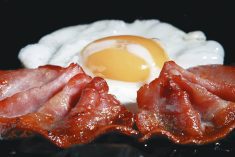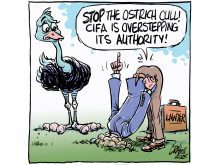The advent of reliable pour-on and injectable endectocides has made cattle scratching from lice or mange a rare occurrence.
In late fall and early winter, veterinarians are sometimes called to investigate the efficacy of these products. These investigations can tell us a lot about cattle scratching behaviour.
When called by a pharmaceutical company representative to investigate scratching, it’s important for the vet to closely examine the cattle. A visual observation over the fence is not enough.
The vet should examine several affected animals and clip an area surrounding the worst affected areas.
Read Also

Budget seen as fairly solid, but worrying cracks appear
The reaction from the agriculture industry to prime minister Mark Carney’s first budget handed down November 4th has been largely positive.
Careful observation with the naked eye or a magnifying glass can detect some external parasites if they are present. Deeper skin scrapings can also be done to detect the possibility of mange mites.
In my experience, the companies making these products are conscientious and want to identify the cause of a problem with certainty.
Endectocide failures are rare but if they do occur, usually the culprits are either biting lice (Damalina bovis spp.) or chorioptic mange.
These external parasites are surface feeders and move around so control can be difficult. Also, transmission is rapid so new animals can easily spread it around a herd.
A common question is when and how long ago the new animals were introduced to the herd and whether they had been previously treated.
This, together with proper dosage and application based on accurate body weights, is extremely important.
Application guns for endectocides disperse the product more accurately over the back.
There are other causes of scratching.
Ringworm is commonly seen around the eyes and head. If severe enough, it will cause irritation and scratching, especially in young cattle.
If the ringworm is in other locations, you have to look closely to see the circular lesions. One treatment for ringworm will usually get the animal on the road to recovery.
Bale processors and other grinders do a great job of chopping and dispersing feed. The only negative is a lot of dust and debris ends up in the animals’ hair.
In warmer weather, the animals’ scurf and debris can cause intense itchiness in certain locations.
Once cattle start rubbing, soreness and bleeding occur, adding to the problem. A lot of these itching episodes will often follow unseasonably warm periods in the winter after cattle have haired up.
Mites in grain or on bedding also cause cattle to itch.
Certain individual or genetic strains may be allergic to certain feeds or moulds.
Allergic reactions will vary in severity but many will cause reddening of the skin and swelling associated with itchiness. Here the allergen must be removed before recovery can happen.
A cow’s skin must be nutritionally healthy. Otherwise deficiencies might cause itching.
Trace minerals should always be fed as part of the overall nutritional package. Important to skin health are zinc, copper and vitamins, especially vitamin A.
Unhealthy skin also allows bacteria to take hold. These infections can be intensely itchy and can spread locally.
Show cattle that have been washed must be thoroughly rinsed or residual soaps can cause irritation or allergic reactions.
Some rubbing and licking are part of the natural grooming process. It is only when this occurs in excess – where hair loss and skin damage occurs – that we should be concerned.
Constant irritation, regardless of the cause, can result in weight loss and a predisposition to other diseases.
If sucking lice are involved, cattle will eat less and anemia can result from blood loss.
Hair loss also removes a cow’s insulating coat. In intense cold, this causes stress and requires more energy to keep cattle warm.
Routinely using an endectocide treatment will eliminate most parasitic causes of scratching.
If scratching continues, have the problem diagnosed so preventative measures can be taken to eliminate the problem.
Roy Lewis is a veterinarian practising in Westlock, Alta.














